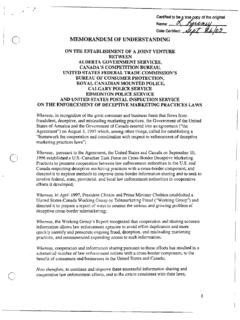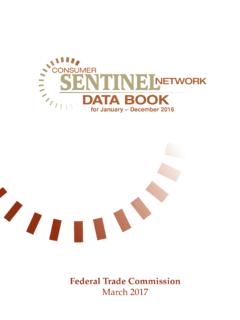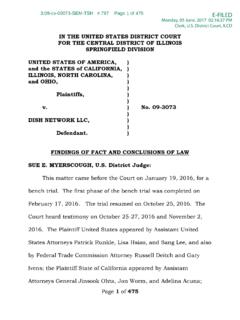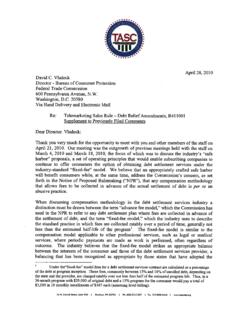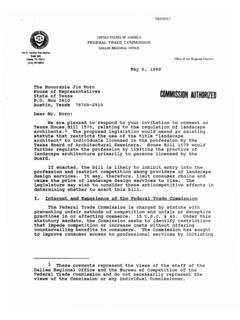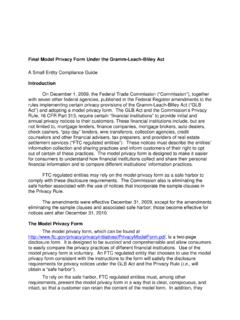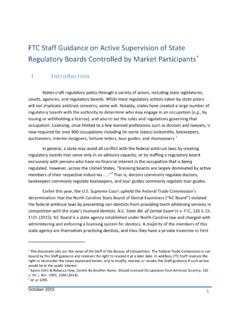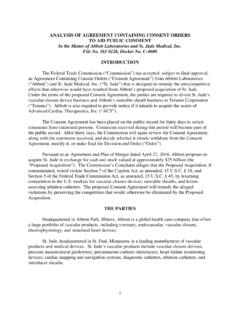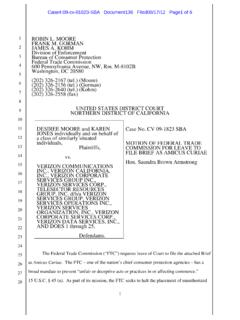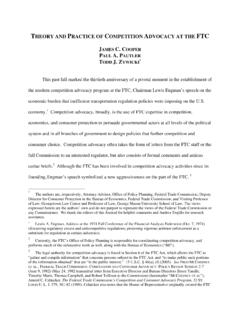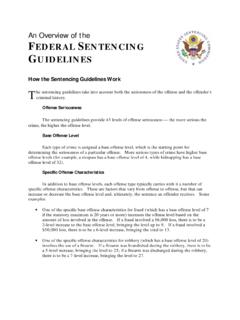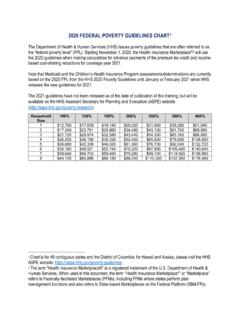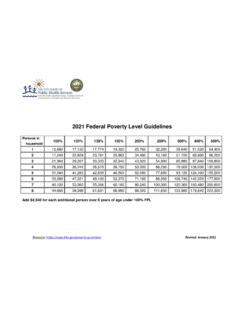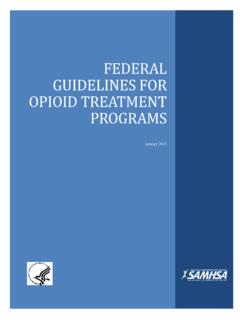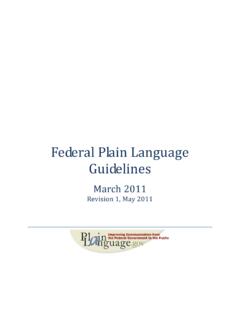Transcription of Vertical Merger Guidelines - Federal Trade Commission
1 Vertical Merger Guidelines Department of Justice &. The Federal Trade Commission June 30, 2020. Table of Contents 1 1. 2 Evidence of Adverse Competitive 3. 3 Market Defnition, Related Products, Market Shares, and 3. 4 Unilateral Efects .. 4. Foreclosure and Raising Rivals' Costs .. 4. Access to Competitively Sensitive 10. 5 Coordinated Efects .. 10. 6 Procompetitive Efects .. 11. DEPARTMENT OF JUSTICE AND THE Federal Trade Commission . Vertical Merger Guidelines . 1. OVERVIEW. These Vertical Merger Guidelines outline the principal analytical techniques, practices, and enforcement policies of the Department of Justice and the Federal Trade Commission (the Agencies ) with respect to a range of transactions often described as Vertical mergers and The relevant statutory provisions include Section 7 of the Clayton Act, 15.
2 18, Sections 1 and 2 of the Sherman Act, 15 1 2, and Section 5 of the Federal Trade Commission Act, 15 45. Most particularly, Section 7 of the Clayton Act prohibits any Merger or acquisition if, in any line of commerce or in any activity affecting commerce in any section of the country, the effect of such acquisition may be substantially to lessen competition, or to tend to create a monopoly. This provision applies to Vertical mergers , as Congress made plain in the 1950 amendments to the Clayton Act. These Guidelines describe how the agencies analyze a range of non-horizontal transactions.
3 Where they use the term Vertical , that term should not be read to narrow the applicability of these Guidelines . The analytical techniques, practices, and enforcement policies described in these Guidelines apply to strictly Vertical mergers (those that combine firms or assets at different stages of the same supply chain), diagonal mergers (those that combine firms or assets at different stages of competing supply chains), and Vertical issues that can arise in mergers of complements. In describing a Vertical relationship, a stage closer to final consumers (such as a distributor, retailer, or finished goods manufacturer) is termed downstream, and a stage further from final consumers (such as a supplier, wholesaler, or input manufacturer) is termed upstream.
4 mergers often present both horizontal and Vertical elements, and the Agencies may apply both the Horizontal Merger Guidelines2 and the Vertical Merger Guidelines in their evaluation of a transaction. In addition, if one of the parties to a transaction could use its pre-existing operations to facilitate entry into the other's market, the Agencies may consider whether the Merger removes competition from a potential entrant, using the methods described in the Horizontal Merger Guidelines . These Guidelines are intended to assist the business community and antitrust practitioners by increasing the transparency of the analytical process underlying the Agencies' enforcement 1.
5 These Guidelines supersede the extant portions of the Department of Justice's 1984 Merger Guidelines , which are now withdrawn and superseded in their entirety. They reflect the ongoing accumulation of experience at the Agencies. These Guidelines may be revised from time to time as necessary to reflect significant changes in enforcement policy, to clarify existing policy, or to reflect new learning. 2. Dep't of Justice & Fed. Trade Comm'n, Horizontal Merger Guidelines (2010). 1. decisions. They may also assist the courts in developing an appropriate framework for interpreting and applying the antitrust laws to the types of transactions discussed These Guidelines should be read in conjunction with the Horizontal Merger Guidelines .
6 Many of the principles and analytic frameworks used to assess horizontal mergers apply to Vertical mergers . For example, Section 1 of the Horizontal Merger Guidelines describing in general terms the purposes and limitations of the Horizontal Merger Guidelines and the goals of Merger enforcement is also relevant to the consideration of Vertical mergers . Other topics addressed in the Horizontal Merger Guidelines , but not addressed herein such as the analytic framework for evaluating entry considerations, the treatment of the acquisition of a failing firm or its assets, and the acquisition of a partial ownership interest are relevant to the evaluation of the competitive effects of Vertical mergers as well.
7 Vertical mergers , however, also raise distinct considerations, which these Guidelines address. For example, Vertical mergers often benefit consumers through the elimination of double marginalization, which tends to lessen the risks of competitive harm. While the agencies more often encounter problematic horizontal mergers than problematic Vertical mergers , Vertical mergers are not invariably innocuous. These Guidelines describe the framework applied by the Agencies in distinguishing anticompetitive from procompetitive (and competitively neutral).
8 Vertical mergers . As with horizontal mergers , the Agencies normally examine effects on the actual and potential direct customers of the merging parties, and, if different, the final consumers of firms that utilize the goods or services of the merging parties. The Agencies are concerned with harm to competition, not to competitors. When a Merger involves products at different levels of a supply chain, the direct customers the Agencies will consider are actual and potential buyers of the downstream products. Absent convincing evidence to the contrary, the Agencies presume that adverse effects on these direct customers lead to adverse effects on final consumers.
9 The enhancement of market power by buyers, sometimes called monopsony power, has adverse effects comparable to the enhancement of market power by sellers. The Agencies employ an analogous framework to analyze Vertical mergers that may enhance the market power of buyers. In evaluating effects, the Agencies focus on the likely changes in competitive outcomes caused by a Merger . Therefore, the Agencies focus on competitive outcomes caused by conduct that would be compatible with firms' abilities and incentives following a Vertical Merger , but would not be in the absence of the Merger .
10 To the extent practicable, the Agencies use a consistent set of facts and assumptions to evaluate both the potential competitive harm from a Vertical Merger and the potential benefits to competition. 3. These Guidelines are not intended to describe how the Agencies will conduct the litigation of cases they decide to bring. Although relevant in that context, these Guidelines neither dictate nor exhaust the range of evidence the Agencies may introduce in litigation. 2. 2. EVIDENCE OF ADVERSE COMPETITIVE EFFECTS. The Agencies consider any reasonably available and reliable evidence to address the central question of whether a Vertical Merger may substantially lessen competition.
